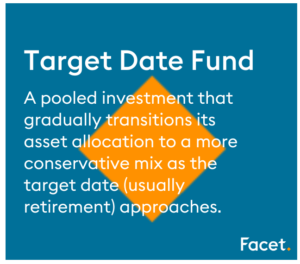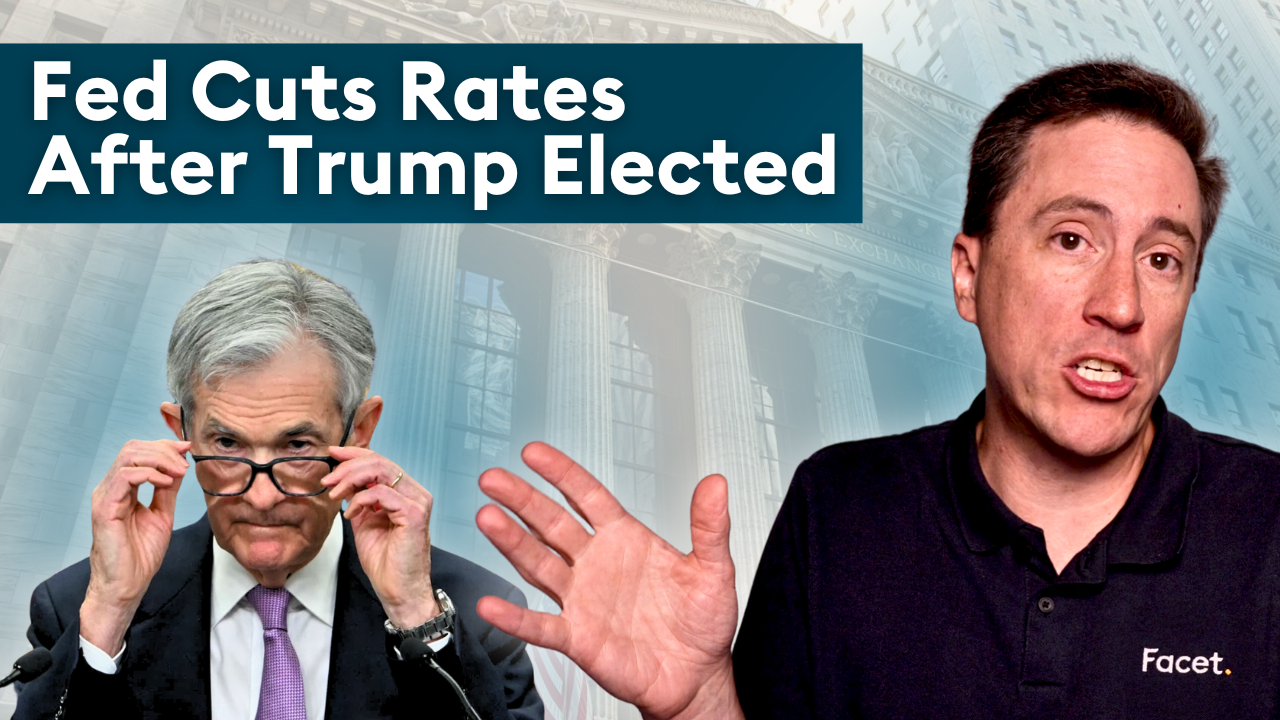
Key takeaways
- Target-date funds are all-in-one investments designed for retirement planning
- They help assume greater risk in younger years and gradually adopt a more conservative approach
- Asset allocation in target-date funds refers to how they divide assets among stocks, bonds, and other investments
- Consist of diversified investments inside mutual funds and ETFs
- Rebalancing is performed regularly to align the portfolio's asset mix with investor's age
Here’s everything you need to know about target date funds (target retirement funds), from understanding their asset allocation strategy to evaluating them as part of your retirement plan.
Understanding target-date funds
Target-date funds (lifecycle funds) have been a mainstay of personal finance for nearly thirty years. In short, they’re an all-in-one investment designed to streamline retirement planning.
They’re built to help you assume greater risk in your younger years and gradually adopt a more conservative approach as you near retirement.
The goal? To accumulate assets for a specific retirement goal, hence the term “target date.“
Though seemingly complicated, target-date funds are quite simple. Most target-date funds work on a traditional portfolio management approach. You select a fund with a target date that aligns with your anticipated retirement year (e.g., XYZ 2035 Fund).
Over time, the fund rebalances to adjust the risk profile as the target date approaches, aiming to achieve the desired investment return.

The basics of asset allocation in target-date funds
Asset allocation is a term that often comes up when discussing target-date funds. But what does this mean?
In its simplest form, asset allocation refers to how a fund, such as an asset allocation mutual fund, divides its assets among various types of investments, such as stocks, bonds, and other investments known as asset classes.
This is a standout feature of target-date funds. They aim to balance risk and return by adjusting the asset allocation throughout the fund’s term, gradually shifting to a more conservative approach, such as:
- increasing the proportion of fixed-income investments like bonds
- reducing exposure to riskier assets
- increasing the proportion of lower-risk investments
As the target date approaches, the target date fund holdings become more conservative, reducing exposure to riskier assets and increasing the proportion of lower-risk investments. This strategic balance is designed to protect your portfolio as you near retirement.
The ‘glide path’ explained
The term “glide path” might be unfamiliar for those new to investing. However, it’s a crucial component of target date funds.
The glide path refers to the evolution of the fund’s asset mix over time, transitioning from a greater emphasis on stocks to a greater emphasis on bonds as the retirement date draws near.
The primary benefit of a glide path is risk reduction. As you near retirement, you likely want to take on less risk with your investments.
The gradual transition from riskier assets to more secure ones ensures a progressively conservative investment strategy as the target date nears, systematically decreasing investors’ risk exposure and enhancing stability as they approach retirement.
Investments, management, and rebalancing
What do target date funds invest in?
Target date funds consist of various underlying investments, almost exclusively within mutual funds and, recently, in exchange-traded funds (ETFs). This structure enables them to diversify broadly across stocks, bonds, and other portfolio assets.
As the target date approaches, the composition of the retirement fund changes, gradually moving out of riskier stocks and into more stable bonds.
Professional management and rebalancing
Portfolio managers conduct research and make strategic decisions to potentially add value or attempt to outperform certain benchmarks for the investors in target-date funds.
Rebalancing plays an important role in fund management. Fund managers generally rebalance target date funds annually, although some funds may opt for daily or monthly rebalancing.
The purpose of this rebalancing is to adjust the portfolio’s asset mix to align with the glide path, ensuring a gradual shift to a more conservative approach as the target retirement date approaches.
How to compare target-date funds
Target date funds can vary widely in terms of cost and investment strategies.
Expense ratios and fees
A fund’s expense ratio is the total annual cost an investor pays, represented as a percentage of assets in the fund. In 2022, the average asset-weighted target fund expense ratio was 0.32%.
Using the average cost of 0.32% as an example, if you invest $100,000, you would pay $320 annually in fees.
These expenses will vary, especially when comparing mutual funds vs. ETFs. Mutual funds tend to be more expensive due to their active investment approach, while passively managed ETFs are generally cheaper. Even a slight percentage variance in fees can accumulate over time, significantly impacting your returns.
How to identify hidden investment fees in your portfolio
Investment strategies
Apart from fees, a target date fund’s investment strategy can significantly impact its performance and risk.
Some funds may follow an active management strategy, where professional managers actively conduct research and make strategic decisions. Others might follow an index-tracking strategy, aiming to replicate the performance of a market index.
There are also hybrid strategies that combine features from active and passive management. Regardless of the strategy, remember that no single approach guarantees superior performance. Hence, selecting a target date fund whose strategy aligns with your investment goals and risk tolerance is crucial.
Aligning your financial plan with a target date fund
Aligning a target date fund with your financial plan involves assessing your risk tolerance and considering how life changes may impact your investment strategy.
Assessing your risk tolerance
Risk tolerance refers to how much investment risk you’re comfortable with. It is a key factor when selecting any investment. After all, you want to ensure that you’re comfortable with the investment risks associated with the fund.
To evaluate your risk tolerance, you can compare funds with similar target dates and examine their investment strategies.
You can also assess your investment goals, time horizon, comfort with short-term loss, and willingness to take on above-average risk for potential returns. This will help you select a target date fund that aligns with your risk tolerance.
Considering life changes and investment adjustments
Life changes can significantly impact your investment strategy. For example, if you decide to retire earlier or later than initially planned, this could result in a shift in the target date of your fund. Subsequently, this would lead to asset allocation and risk profile adjustments to match your revised retirement timeline.
Furthermore, other life changes, such as marriage, having children, or buying a home, can also impact various aspects of your financial life, potentially triggering an adjustment in your investment strategy.
“If you had no other choice, a target date fund would probably be good enough. But we don’t think you should aim for good enough. We think a more thoughtful approach increases your likelihood of success.”
Tom Graff | Chief Investment Officer - Facet
Beyond your target date: What happens after retirement?
So, you’ve reached your target retirement date. What happens to your target date fund now?
Contrary to what one might think, the fund doesn’t always stop adjusting its asset allocation at the target date. Some funds continue to adjust their asset allocation or merge with other funds to focus on generating income and managing post-retirement risks.
Here comes the role of the “to” versus “through” retirement approach. “To” funds reach their most conservative allocation at the target date and typically do not alter their asset allocation after the target date.
On the other hand, “through” funds continue to adjust beyond the target date, aiming to manage income and inflation risk post-retirement.
The “To” vs. “Through” retirement approach
The “to” glide path in target date funds is tailored for investors who anticipate investing in the fund up to retirement. As the target date approaches, a ‘to’ target date fund adjusts its asset allocation to become more conservative in preparation for an investor who plans to begin withdrawing assets at that point.
On the other hand, a ‘through’ target date fund is tailored for investors who anticipate investing beyond the target date. This type of fund maintains its allocation after the target date by gradually transitioning to more conservative holdings over time, addressing the investor’s requirement for continual investment management and potential retirement income.
Managing income and inflation risk post-retirement
Managing income and inflation risk is crucial after retirement. While target-date funds do not offer guaranteed income during retirement and may experience losses if the fund’s stocks and bonds decrease in value, investment companies implement certain strategies to mitigate these risks.
For instance, some target-date funds incorporate Treasury Inflation-Protected Securities (TIPS) in their bond allocations to mitigate inflation risk after retirement.
Retirement accounts and target date funds
Many employer-sponsored retirement plans (e.g., 401(k)s and 403(b)s) offer target date funds as a default investment option. A 2019 study by the Investment Company Institute found that 87% of 401(k) plans offered them in their investment package.
Target date funds don’t just play a role in employer-sponsored retirement plans. They’re also used in individual retirement accounts (IRAs). Within an IRA, target date funds work in much the same way, adjusting the portfolio allocation from growth-oriented investments, like stocks, to more conservative options, such as bonds, as the individual nears retirement.
Final word
Target date funds may be a suitable option for those looking for a hands-off, diversified approach to retirement savings. They offer the convenience of automatic asset allocation and can cater to individual risk tolerance levels and retirement goals.
However, it is important to carefully consider your investment objectives and thoroughly research a fund’s fees and performance history before making any decisions. And remember, it is always wise to talk with a professional for personalized advice tailored to your specific financial situation.
Frequently Asked Questions
Are target-date funds still a good investment?
Target-date funds can be a suitable investment option, especially for those looking for a simple approach to retirement savings. However, staying informed about factors like asset allocation, fees, and investment risk is essential.
What is the minimum investment for target-date funds?
Most target-date funds have a minimum investment requirement of $1,000 to ensure accessibility to a wide range of investors. Some funds may waive the investment minimum if you make monthly deposits to your account.
What is the glide path in target date funds?
The glide path in target date funds refers to the transition of the fund’s asset mix over time, shifting from a focus on stocks to a focus on bonds as the retirement date approaches. This helps manage risk and adjust the portfolio based on the investor’s changing needs.
What life events might necessitate investment modifications in target date funds?
Consider rebalancing your portfolio and adjusting for changes in tax liability when you get married, have children, or purchase a home to ensure your target date fund is aligned with your current financial situation and goals.


